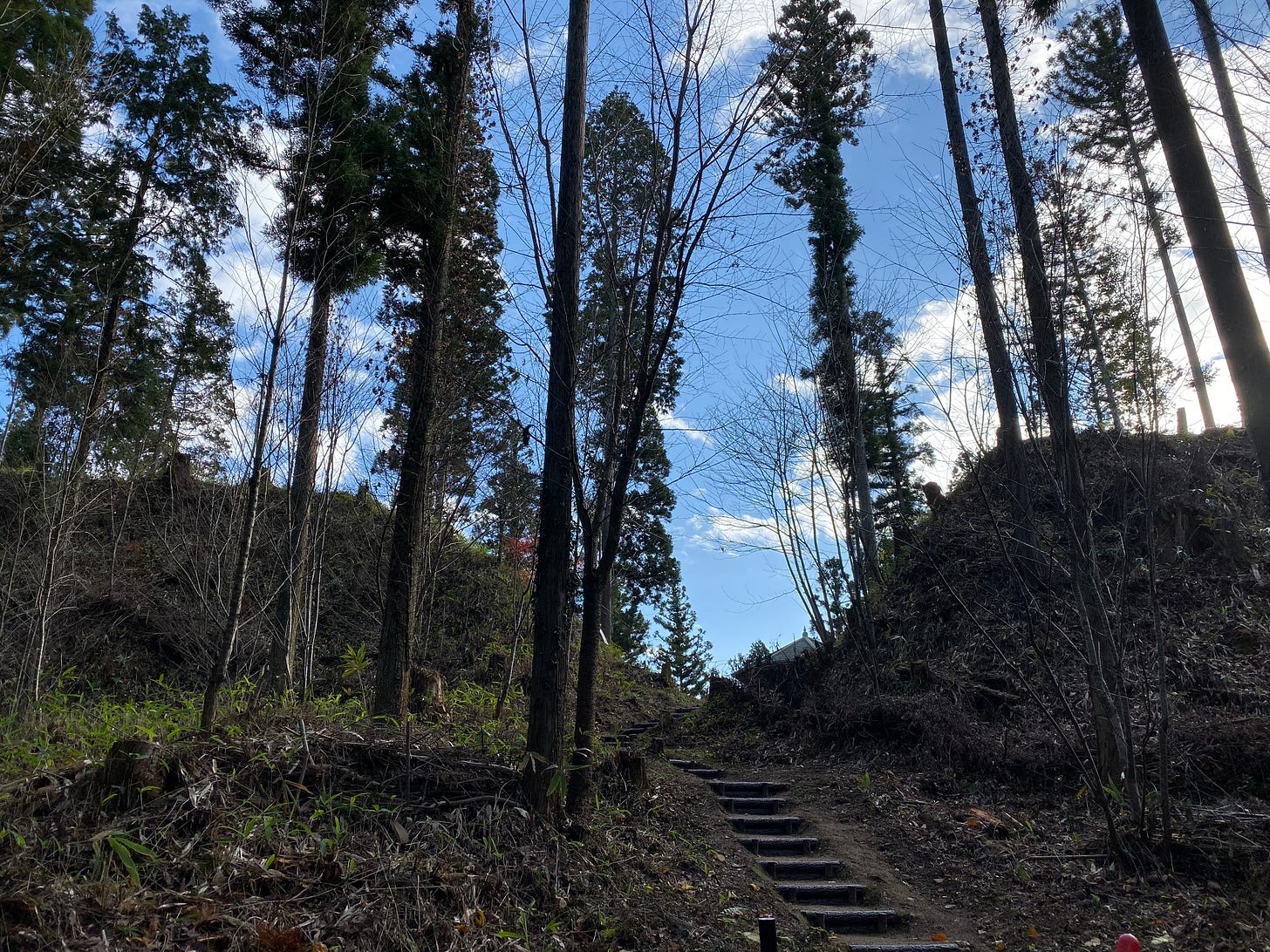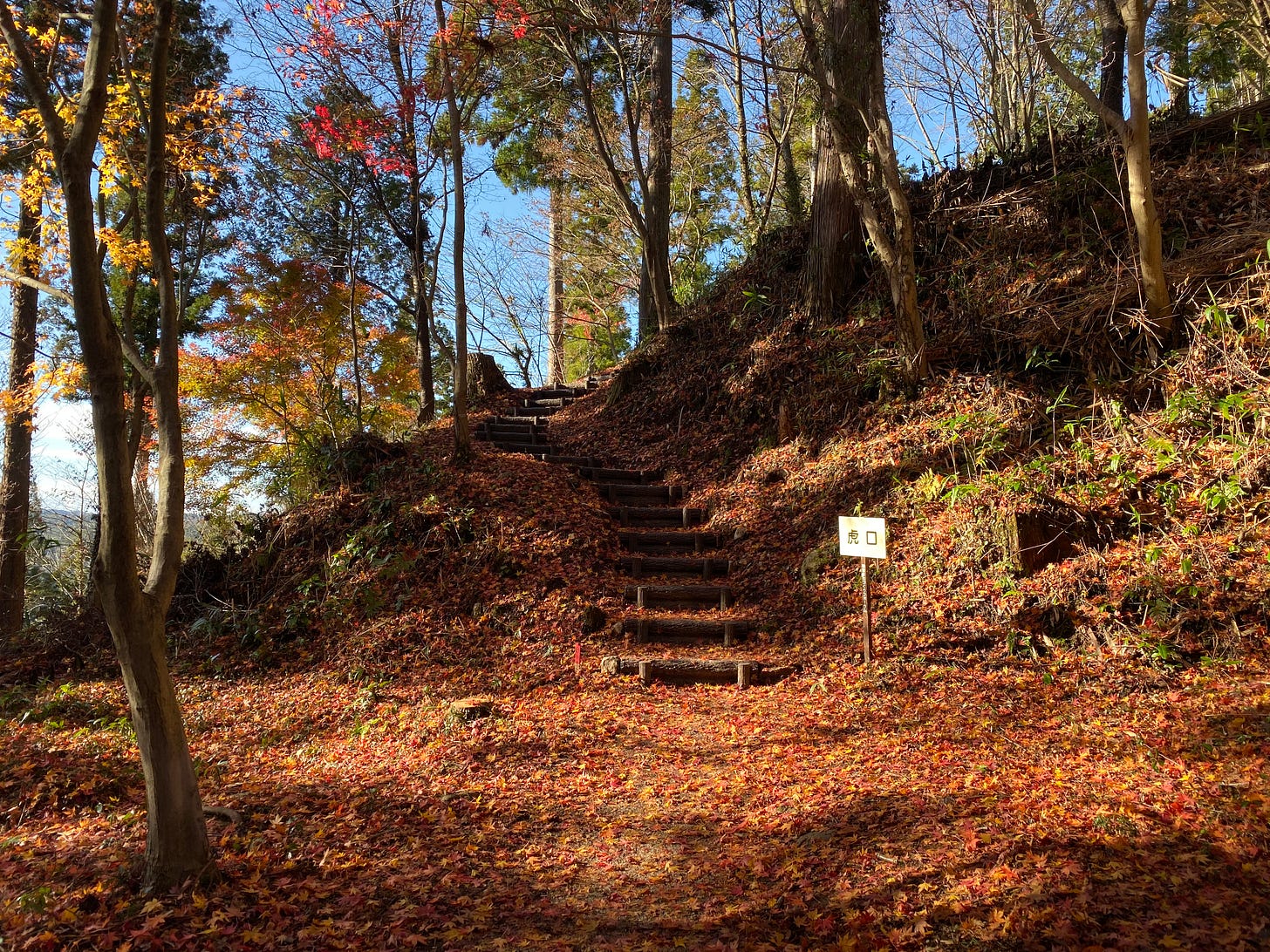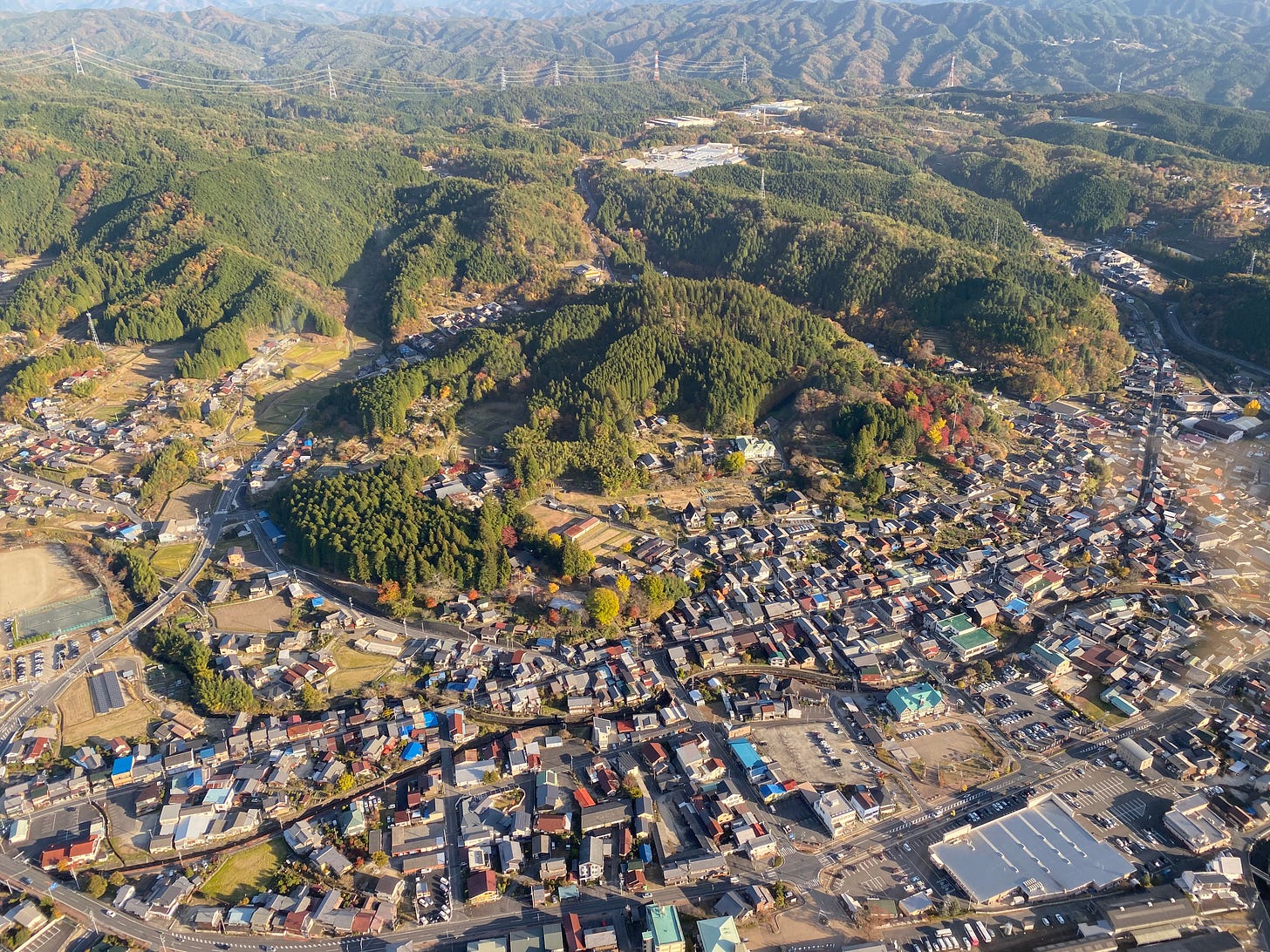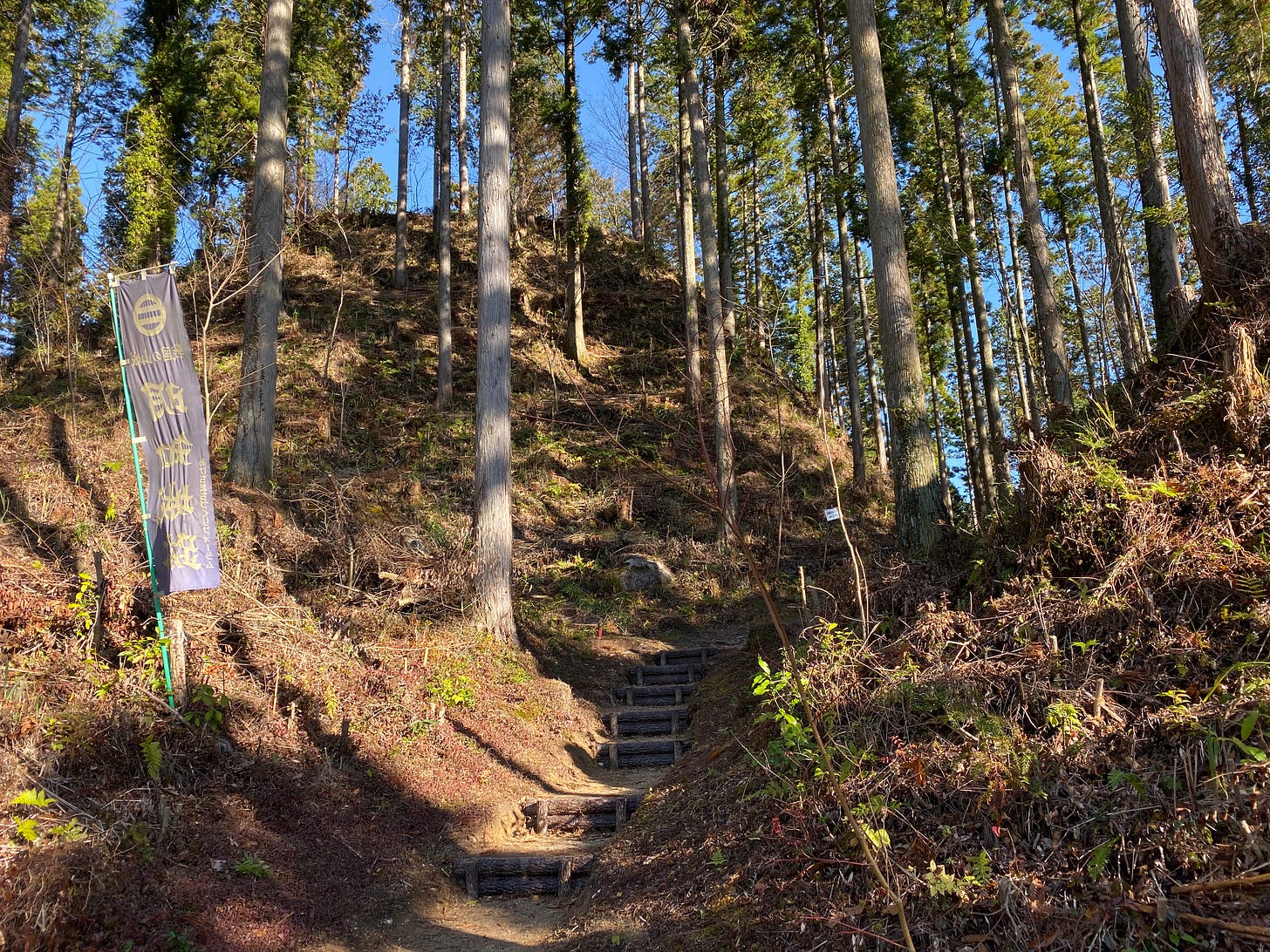Ena’s Akechi Castle (明知城) is an ancient hirayamajiro (mountain and flatland castle) built 530 metres above sea level in Akechi, Mino Province, now Akechi Town, Ena City, Gifu Prefecture. It is also known as Shirataka Castle. The castle was first constructed in 1247 as the clan residence by Toyama Saburobei Keishige, who’s ancestor was Kato Kagekado, an important vassal of the Shogun Minamoto no Yoritomo. Kato Kagekado became the master of the Toyama-so region, and so his son adopted the region’s name as the new family name, becoming Toyama. Toyama Kageshige, master of nearby Iwamura Castle, was the grandson of Kato Kagekado. It was the residence of generations of the Akechi Toyama clan. In fact, during the late Warring States period, along with Iwamura, Ateru, Myochi, Kushihara, Naegi and Yasugi, the Akechi Castle based clan were known as the Seven Heads of Toyama. Of these, the Iwamura Toyama clan, the Naegi Toyama clan and the Akechi Toyama clan were known as the 'Three Toyama Clans', and were dominant in Mino Province’s Tono region.
The current layout was completed during the Warring States period. This Akechi Castle is the second largest castle site in southern Ena City after nearby Iwamura Castle. There is another Akechi Castle, (also known as Nagayama Castle) in Mino’s Kani. Both Akechi Castles claim to be the birthplace of Akechi Mitsuhide, the man responsible for the attack on, and subsequent death of Oda Nobunaga in the Honno-ji incident of 1582. Which one is correct? More on that later.
Akechi Castle was built overlooking strategic transport routes, with roads leading to Iwamura to the south-west, Ena in the north, Iida in Ina-gun, Shinano to the east, Toki-gun to the west, Asuke in Kamo-gun, and Mikawa and Okazaki to the south. Located on the border between Shinano and Mikawa Provinces, it was the scene of numerous battles between the Takeda and Oda clans, both aiming to conquer Mino. The Toyama family initially allied themselves with Takeda Shingen, but Toyama Kageyuki, lord of Akechi Castle, later joined Oda Nobunaga's forces.
In terms of both scale and structure, Ena’s Akechi Castle is a magnificent site, and recent tree felling and maintenance have made it even easier to appreciate.The remains of the castle are spread over the entire mountain, covering an area 400m east to west and 300m north to south, and is centred on the two main baileys at the top of the mountain. The castle makes very good use of the rugged terrain and features over 23 fortifications of various size and style. Of particular note are the large karabori (dry moats) that surround theHonmaru, as well as the steep kirigishi (enhanced steep hillsides) and rows of tatebori (vertical moat) groupings. Multiple tatebori are quite rare in the Ena region, and it has not been determined if these are original early Warring States period, or later additions to the site. Other points of interest include the basic ishigaki, consisting of rows of very large rocks, laid flat along the front of the de-maru, outer compound. This is a real battle-ready designed castle. The earthworks and general layout are superb!




Strategically located on on the border between Mino and Shinano Provinces, numerous battles were fought here between the Oda and Takeda clans. The castle was captured by Takeda Shingen’s vassal, Akiyama Nobutomo, (aka The Raging Bull of the Takeda!) and again by Oda Nobutada, eldest son of Oda Nobunaga. and Mori Nagayoshi, a general of Toyotomi Hideyoshi. After Hideyoshi's death, Mori Tadamasa, Nagayoshi's younger brother, was transferred to Kawanakajima and was replaced by Tamaru Naomasa, but during the Battle of Sekigahara, Naomasa became the guard of Osaka Castle and was captured by the Western Army, which was recaptured by Toyama Toshikage with his heir son Toyama Kazakage.
Toyama Kageyuki was killed in the Battle of Kamimura, fought on 28 December 1570. The following day, 29 December 1570 Akechi Castle was recaptured.
The Akechi Toyama clan was no match for the Akiyama forces and so they asked Oda Nobunaga for help. Nobunaga promptly dispatched Akechi Mitsuhide and ordered him to drive the Akiyama forces out of Mino territory. The two armies faced each other at Odago village on the border between Mino and Mikawa where the Battle of Odago took place, and after three days of fierce fighting, the Akiyama forces were defeated and retreated to Shinano.
In 1572 at the request of Shogun Ashikaga Yoshiaki, Takeda Shingen decided to go to Kyoto. He ordered Akiyama Nobutomo, lord of Takato Castle, to lead a force of 3,000 men and invade Mino. In November, Iwamura Castle was besieged, and its master, Toyama Kage-no-tachi, who had been wounded in battle against the Takeda forces three years earlier, died the following year, and Akechi Castle was destroyed in February 1574.
At the behest of Takeda Shingen, Takeda Katsuyori attacked Akechi Castle with a massive 15,000-strong army. Toyama Kazuyuki, lord of Akechi Castle, his uncle Toshikage and others prevented the attack with only 500 troops and urgently reported the incursion to Oda Nobunaga. Nobunaga understood the importance of Akechi Castle and, together with his son Nobutada and Akechi Mitsuhide whom he had summoned from Tamonzan Castle in Nara, set up a 30,000-strong force at Tsurukayama, west of Akechi Castle, and attempted to assist the besieged Akechi forces.

However, a samurai named Iiwa Maemon betrayed the castle, attacking his allies, the Sakai troops who had been stationed there as reinforcements. The castle grounds were set on fire and captured by the Takeda. All 500 defenders were killed In this battle. Akechi Castle became the 17th of the 18 castles of the Toyama to fall to the Takeda. Toyama Toshikage managed to flee to his wife's family, the Suzuki clan of Asuke Castle.
Following Oda Nobunaga's defeat of Takeda Katsuyori at the Battle of Nagashino in May of 1575, Nobunaga’s son and heir, Nobutada, recaptured the castles occupied by the Takeda one after another, and Akechi Castle again became an Oda stronghold. Toyama Toshikage returned to Akechi Castle.
Toyama Toshikage would then be forced to call upon Tokugawa Ieyasu for assistance in 1583, following the death of Nobunaga. Toyotomi Hideyoshi had since usurped Oda clan power and lands, driven out Nobunaga's third son Nobutaka, the lord of Mino, and had him commit suicide. Ikeda Tsuneoki was made lord of Gifu Castle, and his son-in-law Mori Nagayoshi, was entrusted with East Mino. Feeling oppressed, Toyama Toshikage, together with his cousin Kozato Mitsuaki (Wada Sukeemon), turned to the Suzuki clan in Asuke. Toshikage's wife was the daughter of Suzuki Shigenao, while Kozato Mitsuaki's sister was the wife of Suzuki Nobushige, Suzuki Shigenao's heir and the current head of the clan. The Suzuki clan were also related to the Tokugawa and came under Ieyasu's control. Tokugawa Ieyasu's great-aunt and foster-mother, Matsudaira Hisako, had been the wife of Suzuki Shigenao.
In April of 1584, Akechi Castle was recaptured again. During the Battle of Komaki-Nagakute, the Toyama forces were incorporated into Suganuma Sadatoshi's forces. As Mori Nagayoshi, lord of Iwamura Castle, was killed in the Battle of Nagakute, Akechi Castle was retaken on Ieyasu's orders. However, Ieyasu requested Toyotomi Hideyoshi return the castle to Mori Tadamasa, Nagayoshi's younger brother, and Mori Sakon became the castellan of Akechi Castle.
In October of 1600, during the Battle of Sekigahara, the Tamaru clan, together with the Sanada of Oyama, decided to betray Ieyasu and joined the Western Army. Ieyasu ordered Toyama Toshikage to recapture East Mino, as it was assumed that Tokugawa Hidetada's army would pass through along the Nakasendo route heading to Serkigahara. Together with Toshikage's sons Kakage and Kozato Mitsuaki, and with thecooperation of the lord of Tsumaki Castle, they drove the Tamaru forces out, captured Akechi Castle and eastern Mino area and liberated Iwamura Castle.
For his success in pacifying the region, Toyama Toshikage was given 6,700 koku in the Ena and Toki regions and became a Tokugawa clan hatamoto. Of the 5,000 Edo period bannermen, less than 50 were awarded more than 6,000 koku.
Toyama Toshikage remained the castellan until 1615, when the Tokugawa One-County-One-Castle law saw Akechi Castle abandoned. The Akechi Toyama clan then ruled the area from Akechi jinya built at the foot of the mountain, until the Meiji Restoration in1868.
Below the mountain are the Akechi Toyama clan Edo period residences, including the jinya fortified manor, and remains of a water moat. The castle town below the ruins is currently promoted as “Taisho Mura”, as the townscape contains many Taisho period (1912-1926) buildings and other attractions. Thankfully it has one of the best designed mountain castles above it, and one can play Sengoku Samurai to one’s hearts content. BYO armour.
So, which Akechi Castle is the birthplace of Akechi Mitsuhide? While many suggest the Kani Akechi Castle, Mitsuhide’s father’s castle, my own personal belief is that Akechi Mitsuhide was born in Ena Akechi Castle, as this was his mother’s origins. It is most probable that his mother would have returned to her parents’ home to give birth to her son, Mitsuhide, as was the common practice in those days, and after the birth, returned to her husband’s Akechi Castle in Kani. It is also highly possible that the young Mitsuhide spent time between both castles, and may have been educated in Ena, as there are records showing that he was tutored by a well-known priest there. The site of the old classroom is also signposted. Mitsuhide’s mother’s grave is located near the site of Ena Akechi Castle. Some 750 meters southwest of the Akechi Castle site is Ochiai Toride (fortress), a satellite castle to Akechi which contains the remains of an old well called “Mitsuhide's Sanyu Well”, supposedly from where his first bathwater was drawn. A grave for Akechi Mitsuhide can be found at the Ryugoji Temple, about 200 meters north of Taisho Village Hall, along with the tombs of 11 generations of the Akechi Toyama clan, including that of descendant, Toyama no Kin-san, the tattooed Edo period magistrate (who once had his own TV series!) At Hachioji Shrine, west of Ryugoji Temple is a tree said to have been hand-planted by Mitsuhide. The Kani Akechi Castle is a bit suspicious, and I tend to think that it wasn’t much of a castle at all (put aside three hours and I’ll tell you why!)
Traveling by car, park in the free parking lot of Nihon Taisho-mura center and walk up to the castle via the ruins of the Akechi Jinya (water moat and kabuki-styled Ote-mon Gate) that remain on the west side, or park in the parking space (about 4 cars) on the west side of Akechi Castle. By train, walk through the retro streets of Taisho-mura, via the ruins of Akechi Jinya at the foot of the castle, and the former Miyake Family home, the Akechi Mitsuhide Academy and Tenjin Shrine, climb to Akechi Castle and walk in an anti-clockwise direction (the route from Akechi Jinya to Akechi Castle can be done from either the north or the south side, the south side is easier, and shows the castle off best!).
Knowing the action it has experienced, and the history behind it, you’ll enjoy this castle!





